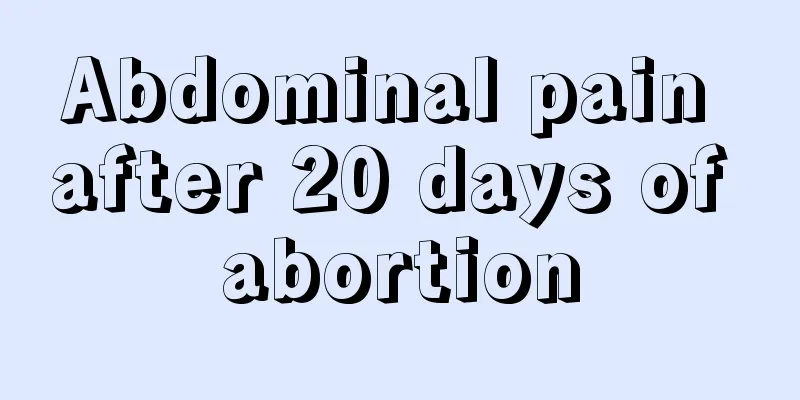Abdominal pain after 20 days of abortion

|
Abortion is extremely harmful to the human body, but some friends have no choice since they have chosen it. After an abortion, you must scientifically condition your body so that it can recover faster. It is actually normal to experience dull abdominal pain 20 days after an abortion, because abortion can cause serious damage to the health of the uterus. Any discomfort symptoms after an abortion should be promptly reviewed and diagnosed. Whether it is a natural birth or a caesarean section, pain is unavoidable. The only difference is that the pain of natural birth occurs during the delivery process, while the pain of caesarean section starts after delivery. So, what issues should be paid attention to in postpartum care after cesarean section? Use less analgesics. Generally, the wound begins to hurt severely a few hours after the cesarean section. In order to get a good rest and recover as quickly as possible, you can ask your doctor to give you some painkillers on the day of surgery or on the night of surgery. After this, be more patient with the pain and it is best not to use painkillers to avoid affecting the recovery of intestinal motility. Generally speaking, the pain from the wound will disappear on its own after 3 days. The patient should be turned over more often after surgery. Anesthetic drugs can inhibit intestinal peristalsis and cause varying degrees of intestinal flatulence, thus causing abdominal distension. Therefore, it is advisable to do more turning movements after delivery to promote the early recovery of the paralyzed intestinal muscle peristalsis function and expel the gas in the intestine as soon as possible. It is advisable to lie in a semi-recumbent position in bed. The body of a mother who has undergone a cesarean section recovers slowly, and she cannot get up and move around 24 hours after delivery like those who have given birth naturally through vaginal delivery. Therefore, those who have undergone cesarean section are prone to difficulty in expelling lochia. However, if they adopt a semi-recumbent position and turn over more often, it will help the lochia to be discharged, avoiding the lochia from accumulating in the uterine cavity and causing infection that affects the repositioning of the uterus. It will also help the healing of the uterine incision. Pay attention to urination after delivery. As soon as you feel the urge to urinate, you should try to urinate on your own to reduce the risk of urinary tract bacterial infection caused by keeping the catheter in place for too long. Keep the vulva and abdominal incision clean within 2 weeks after the operation, avoid getting the abdominal incision wet, and use sponge baths to clean the whole body. You can shower after that, but you must not take a tub bath until the lochia is completely discharged; rinse the vulva 1-2 times a day, and be careful not to let dirty water enter the vagina; if the wound becomes red, swollen, hot, or painful, do not squeeze or apply it at will, and you should seek medical attention in time to avoid prolonged infection of the wound. Try to get out of bed and move around as early as possible. As long as your physical strength allows, you should get out of bed and move around as early as possible after giving birth. It can not only increase intestinal peristalsis and promote uterine repositioning, but also avoid intestinal adhesion and thrombophlebitis. It takes about 24 hours after a cesarean section for gastrointestinal function to recover. After the gastrointestinal function recovers, give liquid food for one day, such as egg soup and rice soup. Avoid eating gas-inducing foods such as milk, soy milk, and large amounts of sucrose. After the intestinal gas is cleared, switch to semi-liquid food for 1-2 days, such as porridge, noodle soup, wontons, etc., and then switch to a normal diet. Sexual intercourse is absolutely prohibited during the postpartum period. 100 days after a caesarean section, if there is no more vaginal bleeding and the doctor checks that the wound is healing well, you can resume sexual life. However, strict contraceptive measures must be taken to avoid pregnancy. Otherwise, the scarred uterus is prone to perforation or even rupture during curettage. Pay attention to doing fitness exercises. About 10 days after the cesarean section, if your body has recovered well, you can start doing fitness exercises, once in the morning and once in the evening, and each time you do it, gradually extend from 2-3 minutes to 10 minutes. |
>>: Abdominal pain 11 days after delivery
Recommend
Who can't eat fennel? How to make fennel dumplings
Fennel is a vegetable that is often used as a fil...
What is the reason for the yellow-green tofu residue secretion?
As we all know, women often have some secretions ...
How to treat a cold during pregnancy
Maybe many of us don’t have a clear understanding...
There are many women who are pleasing to the eyes, but few who are pleasing to the heart.
The hustle and bustle of the world, the changing ...
What causes swollen lymph nodes in the armpits of women?
The problem of swollen lymph nodes is relatively ...
What is cervical hypertrophy and how to treat it
There are many kinds of problems with the cervix....
Can cerebral palsy be diagnosed during prenatal examination?
Cerebral palsy is a disease that cannot be detect...
Is it a good thing to have blood in the second month of pregnancy?
For vaginal bleeding at 14 weeks of pregnancy, a ...
How long does it take for fetal movement to occur during pregnancy?
Fetal movement refers to the movement of the baby...
Risks of having a cesarean section for a third child
Although women who undergo cesarean section do no...
Tips on how to make your hands whiter and softer
It is said that hands are a woman’s second face. ...
Is it normal to miss your period at 45?
According to a survey, the age of menopausal wome...
It’s the right time to protect your health in early spring when the weather is still cold
In early spring, the ground warms up and the gras...
How many months does it take for milk supply and demand to balance?
Women who have just become mothers do not know th...
There is a little suppuration at the cesarean section line
Cesarean section has certain sequelae and side ef...









